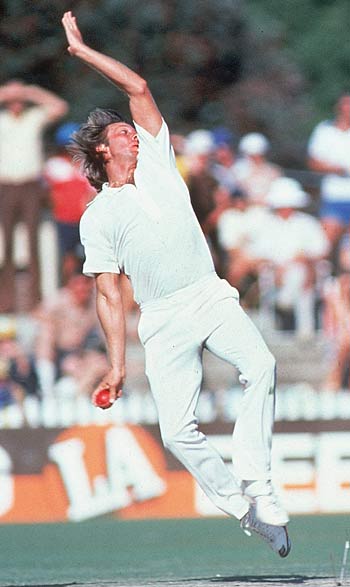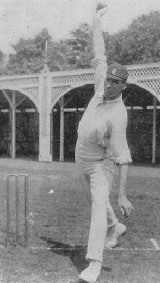SJS
Hall of Fame Member
3. JEFF THOMSON

I don't think a fellow of Jeff Thomson's make-up is about to admit to the ravages of old age. When he was left out of the Australian programme in the 1983-84 summer and passed over again for the tour of West Indies, Thomson accepted it with his usual grace.
"It's a bloody joke", said Thomson after the team to the West Indies was announced. "I ought to be in that team. Somebody ought to ask the West Indians whether they like facing me."
Thommo went on to say that he thought he was as quick as ever and bowling as well as ever. But like it or not, Thomson wasn't even the standby bowler for the West Indies tour. That honour went to Rod McCurdy, a relatively unknown Victorian.
Still, its far too earkly to be writing Thommo's obituary. I speak with a bit of austhority here because a lot of people were prepared to write mine a long while before I was prepared to tuck myself in to the coffin.
Even if he can't force his way back into the Australian side. - and the young Australians are forming a queue behind Geoff lawson, Rodney Hogg, Karl Rackemann and Co. - "two up" still has a great deal to contribute to Queensland in their quest for the elusive Sheffield Shield. In fact, if Western Australia hadn't met Thommo's Queenslanders in the 1983-84 final- and if I hadn't been WA captain in my last first class appearance, I'd have been hoping like hell for him.
Jeff Thomson and I are mates for many years and I like to bring that our partnership as the opening attack brought a little joy to Australians.
Looking back I guess Jeff was the only Australian fast bowler to whom I ever played second fiddle. At his peak, he was the most explosive, lethal and unplayable bowler I have ever seen. His ball pitched just short of a length would rear so sharply that even the lofty Adam's apple of beanpole Tony Greig was in constant danger. His bouncer was downright fearsome. And his yorker, the ball he fondly described as his "sandshow crusher" - was legendary. It was, as commentators are wont to say, a "brute of a ball".
Thomson's biggest attribute in those devastating seasons was his shock value. His unorthodox 'sling' action - the amble up to the bowling crease, then the whiplash delivery - made him unpredictable and so often unplayable.
Sure he could spray them about. But thats what made his so dangerous. One wide down the leg side, one wide of the off stump, the next one plum in line and beating thye batsman pointless.
I think the Australian selectors gave Thommo a pretty raw deal throughout the 1983-84 summer. Surely he was worth at least one international game somewhere along the line. Then again, from a purely selfish viewpoint, if he'd been in, I might have been out - and for me anyway that would never have done.
I'll tell you what though, if I had been selecting the Australian party to tour the West Indies, Jeff Thomson would have been on my short list.

I don't think a fellow of Jeff Thomson's make-up is about to admit to the ravages of old age. When he was left out of the Australian programme in the 1983-84 summer and passed over again for the tour of West Indies, Thomson accepted it with his usual grace.
"It's a bloody joke", said Thomson after the team to the West Indies was announced. "I ought to be in that team. Somebody ought to ask the West Indians whether they like facing me."
Thommo went on to say that he thought he was as quick as ever and bowling as well as ever. But like it or not, Thomson wasn't even the standby bowler for the West Indies tour. That honour went to Rod McCurdy, a relatively unknown Victorian.
Still, its far too earkly to be writing Thommo's obituary. I speak with a bit of austhority here because a lot of people were prepared to write mine a long while before I was prepared to tuck myself in to the coffin.
Even if he can't force his way back into the Australian side. - and the young Australians are forming a queue behind Geoff lawson, Rodney Hogg, Karl Rackemann and Co. - "two up" still has a great deal to contribute to Queensland in their quest for the elusive Sheffield Shield. In fact, if Western Australia hadn't met Thommo's Queenslanders in the 1983-84 final- and if I hadn't been WA captain in my last first class appearance, I'd have been hoping like hell for him.
Jeff Thomson and I are mates for many years and I like to bring that our partnership as the opening attack brought a little joy to Australians.
Looking back I guess Jeff was the only Australian fast bowler to whom I ever played second fiddle. At his peak, he was the most explosive, lethal and unplayable bowler I have ever seen. His ball pitched just short of a length would rear so sharply that even the lofty Adam's apple of beanpole Tony Greig was in constant danger. His bouncer was downright fearsome. And his yorker, the ball he fondly described as his "sandshow crusher" - was legendary. It was, as commentators are wont to say, a "brute of a ball".
Thomson's biggest attribute in those devastating seasons was his shock value. His unorthodox 'sling' action - the amble up to the bowling crease, then the whiplash delivery - made him unpredictable and so often unplayable.
Sure he could spray them about. But thats what made his so dangerous. One wide down the leg side, one wide of the off stump, the next one plum in line and beating thye batsman pointless.
I think the Australian selectors gave Thommo a pretty raw deal throughout the 1983-84 summer. Surely he was worth at least one international game somewhere along the line. Then again, from a purely selfish viewpoint, if he'd been in, I might have been out - and for me anyway that would never have done.
I'll tell you what though, if I had been selecting the Australian party to tour the West Indies, Jeff Thomson would have been on my short list.


 But knock those 3 Tests off, then split his career into pre-WSC and post-WSC and I think you get a pretty decent impression of how deadly then decent he was.
But knock those 3 Tests off, then split his career into pre-WSC and post-WSC and I think you get a pretty decent impression of how deadly then decent he was.





